A 21st Century Zartonk: An iRevival in the Modern Age of iFedayees
95 years of questioning the reality of planned, brutal mass executions, the ethnic cleansing of a people from their place is far too long. Up against a looming deadline, a threat of losing their history and identity, a new generation of Armenians is waking up to an economic collapse, disappearing Diasporas, and questionable leadership. The time has come for modern-day Fedayees to take action, to use modern technologies and create global media messages about their legacy, history, and their future. This is our prophecy.
By Paul Chaderjian and Allen Yekikan
At twenty-four minutes past four o’clock on the afternoon of April 24, a war for cultural survival wages on the streets of this metropolis. In the fight of their lifetime are young Armenians on the sidewalks of Wilshire, changing the rules, questioning Baby Boomer values, inventing a new movement, and sending a message to the world that justice will be served and their ancient culture will survive and thrive.
On the front lines of this epic war are the Digital Natives, Generation Z, armed with nothing more than their cell phones, cameras, and their laptop computers. This war is a battle for cultural revival, a battle to re-energize the Armenian spirit in the far corners of the Diaspora and in suffocated and abused community like Javakhk. This fight is for the universal acknowledgment of the Armenian Genocide and global recognition of the independent Republic of Karabagh. This battle for national survival is not only being waged on these streets of La La Land but in the abstract place called the Internet.
Why is this generation – born into the most pampered of lives – out on the sidewalks instead of sipping beers at a beach-side cantina off the Pacific, on rides in Disneyland, or in the great malls of commerce, shopping, eating, or enjoying a Saturday afternoon matinee?
Where is this sense of injustice and this passion for change coming from? How is their passion being fueled? Why does the world outside their suburban lives matter more now than ever before? And why does a 95-year-old crime against their ancestors warrant the display of such passion – nearly a century later and a world away – on the streets of California?
A Generation in Question
Perhaps these question’s are because the progeny of the Genocide has awakened to an uncertain, apocalyptic future. A new generation of young men and women are coming of age to the threat that their lifestyles may be a memory of the good old days.
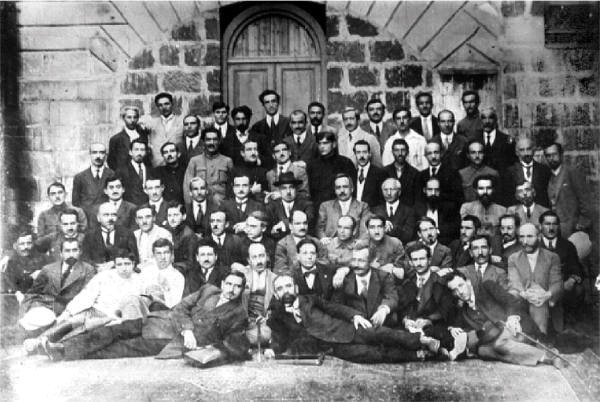 Young people are opening their eyes to headlines that those in their 20s and 30s are facing 50% unemployment. Their jobs have been shipped off to China and India. Their universities are broke and have no room for new students. Their forests are cut down and natural resources fast depleting.Their bankrupt government is waging unnecessary wars overseas, throwing billions of dollars in smart bombs on foreign lands, and their corrupt leaders throwing billions of bonuses to those sociopath capitalists who bankrupted a bogus financial industry.
Young people are opening their eyes to headlines that those in their 20s and 30s are facing 50% unemployment. Their jobs have been shipped off to China and India. Their universities are broke and have no room for new students. Their forests are cut down and natural resources fast depleting.Their bankrupt government is waging unnecessary wars overseas, throwing billions of dollars in smart bombs on foreign lands, and their corrupt leaders throwing billions of bonuses to those sociopath capitalists who bankrupted a bogus financial industry.
Perhaps their stark realities are now coming into focus because they wake up to accusations that their very existence as Armenians is based on a lie. This rabid movement is being ignited because they turn on CNN to hear the Turkish Prime Minister say that there had been no such thing as Genocide and that Armenians had been the criminals that victimized the Turks.
Baby Boomers’ democratic leaders have not only failed at setting the record straight on the Genocide, but they have also failed at guaranteeing that our way of life can be sustainable for the next generation and for generations to come.
Youth today are threatened with the possibility of never owning their own homes, not affording to go on vacations to their ancestral Homeland, and no longer being able to afford to provide an Armenian education to their children or keeping the doors of their ancient churches open that is fueling the crisis.
How does their government and their President get away with destroying their future and making empty promises like ‘change.’ Hadn’t Mr. Obama promised Genocide recognition? Wasn’t he now turning his back on his promises and bowing down to the lying Ottoman politicians of the 21st century?
21st Century Re-awakening
The activists in the 6300 block of Wilshire are following a noble path, a path taversed by their forefathers. One which they were destined to retrace.
When they realized the older generations, in their affluent self-assurance, wasn’t going to listen to their ideas about cultural preservation and nationhood, this generation looked back to their people’s history. They found inspiration in stories about fools and revolutionaries who dared to question authority. They found hope in the actions of those in the late 19th century who ventured into the villages and founded schools, and who brought the European enlightenment to the Armenian countryside.
From Madras/Chanai to Venice/San Lazzaro, in the seminaries, merchant communities, and universities of the Armenian Diaspora, Armenians of the day began to look toward their Homeland with despair. They sought solutions to the nation’s problems. Having grown tired of being told what they couldn’t do by their parents, these individuals began to imagine a better future. They envisioned it and then worked to create it.
What began as a spark became a movement of awakening, a Zartonk, and it spread like a modern-day viral video across the Armenian world. The medium of that era was not the Internet but the printing press. Newspapers, pamphlets, and books created a Diaspora-wide dialogue about cultural, linguistic and social demands. The printing press created a consciousness and awareness that resulted in change.
In the 1700s when Armenians were living under foreign rule, Armenians in the Diaspora experienced the Age of Enlightenment and closely followed the French and American independence movements and the births of democracies.
As the framers of the US constitution were dreaming up their new nation, free from British rule, Armenians like Shahamir Shahamirian were thinking up a bill of rights for Armenians and a means for liberation from Turkish oppression. Their weapon was a printing press, which spread new ideas to the masses.
Through the printed word, ancient tales of heroic exploits and battles were brought to life, dialogue about democratic governance and social justice were popularized, and Armenian students studying in the universities of Europe were given a struggle in which to believe.
Armenians in the Age of Enlightenment gave birth to young enlightened thinkers, selfless teachers, and the fearless Fedayees.
The iPeople
One of the historic acts of the enlightened Armenians was the development a modern language that could be understood by the masses. This Askharabahr became the language of their revolution. It defied the Church and authority to become the medium through which dreams and means for emancipation and liberation were conveyed.
 Today, 21st century Fedayees also have a new way to speak the language of the new masses. Their Ashkharabahr–the language of their world–is the Internet and social media. This new media in the age of hyper-connectivity is the foundation of this reawakening. That any two or ten million Armenians anywhere can come together at anytime through the unfathomable global access of the Internet is what makes the iZaronk a reality.
Today, 21st century Fedayees also have a new way to speak the language of the new masses. Their Ashkharabahr–the language of their world–is the Internet and social media. This new media in the age of hyper-connectivity is the foundation of this reawakening. That any two or ten million Armenians anywhere can come together at anytime through the unfathomable global access of the Internet is what makes the iZaronk a reality.
Armed with their laptops, cell and smart phones, this new breed of freedom fighter is waging a struggle for freedom from their people’s established norms, norms which are staid and are slowly suffocating if not killing a new generation of young Armenians.
Clear, concise messages, video images in abundance, passionate Armenians speaking up, jumping in front of their cameras, getting behind their iPhones, punching their keyboards with words small and big — these are what can and will turn around a people in a deep sleep in the early years of the 21st Century. The time has come, and the alarm is sounding; the war of yesterday is now the war in Cyberspace. The weapon is new media.
Armen loads his video camera with a fresh tape. His batteries are charged. His tripod is set-up. He has his MacBook, and he’s on the front lines of the Armenian Cause in the 21st Century. He knows that supremacy in the information age is getting his messages heard, using the information superhighways prolifically, and producing sexy, viral messages that are watched by millions of people, scoring thousands of hits on the net.
Varant is clicking photos of police officers guarding the Consulate doors. He’s uploading them with captions via his BlackBerry to thousands who are checking his real-time Facebook updates.
These youth are on the front lines of the Internet, where video, audio, and viral messaging can help Armenians reach the tipping point into nationhood, where democracy and social justice prevail; ensure cultural survival; secure the international recognition of the Armenian Genocide; achieve autonomy and self-rule in Javakhk, and protect the inalienable right of self-determination of the people of the Republic of Nagorno Karabakh.
Alina clicks away all day, texting friends, posting messages, videotaping images. She is not wasting her time communicating about which movie she saw or who is dating whom. Instead, she is living and breathing the Armenian Cause, by making the issues on the table more intriguing than what and who is walking on the red carpet or getting drunk in Vegas.
Like Armen, Varant and Alina, thousands of Armenian youth today have greater power than any government, than any conglomerate, than any old-world call-to-arms. Their war of a lifetime is waged through thoughts, through outspokenness, and through clicks on their communications technologies.
The time has come for a 21st century Zartonk, a national revival using the new weapons of modern civilization –the communications tools that every citizen of the world either has access to or knows someone with access. These tools, cameras, keyboards, editing software, iPad and iPods, FlipCams and iPhones, are all what can create the iZartonk.
iMedia
From the dance halls of the Ani barakhoomp, to the Armenian language classes at Mesrobian, from the film sets of the aspiring filmmakers, to the performances of young playwrights, iZartonk is Armenians breaking free of their pedagogical restrains, free of the capitalist poison of accruing more wealth, free of the game of politics.
Along the way, young Armenians are using their Internet connections and their keyboards to not only report about what their generation is doing toward their community’s collective goal of cultural preservation, but they are also using all these platforms of media and communication to ask the questions that needs to be asked. They are asking each other, expressing their opinions, spreading unique stories about the Armenian-American experience and challenging each other for new dreams, new ideas, and calls to action.
What should we believe in? What should we stand for? What should be our plans? How do we protect our community and our rights? These are the messages that are floating back-and-forth on the Information Superhighway. Instead of banal messages on Facebook about what people are having for dessert, how about asking what is a good insurance carrier or where there are new job openings? Instead of feeding the livestock on Farmville or repeating a joke from a morally bankrupt cartoon on cable, why not promote a group fighting to stop capitalist endeavors destroying the Earth?
iFedayees
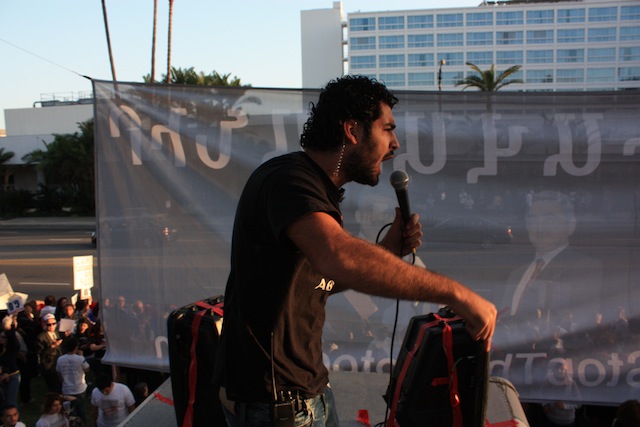 The iFedayees want a say in what their community stands for, what the collective should focus on, not merely accept the ways of their parents’ world. They want to decide whether this community needs multi-million dollar cathedrals, lavish banquet halls, and obscene weddings and parties – all which are depleting resources that could otherwise go towards timeless endeavors.
The iFedayees want a say in what their community stands for, what the collective should focus on, not merely accept the ways of their parents’ world. They want to decide whether this community needs multi-million dollar cathedrals, lavish banquet halls, and obscene weddings and parties – all which are depleting resources that could otherwise go towards timeless endeavors.
iFedayees must roll up their sleeves and know more than just their people’s history. They must also learn about the climate of the world, the Chinese economy, the worlds of the Islam and the South Americas, and how all these factors shape their modern Armenian-American experience.
iFedayees must learn, they must take a stand, and they must be involved in every aspect of their lives and hence their future. This is what revolutionaries do; and this is what young Armenians must do to ensure the survival of their six-thousand year-old-culture and nation – be it in the Homeland or in its vast and ever-relocating Diaspora.
iDo and iWill
In today’s Armenian media, instead of stories about the legendary heroes of the people who took up arms to protect their fellow Armenians, there are stories of the mafiosos stealing from the government, the masses, and each other. Instead of notions of equal rights and freedoms, instead of stories of revolutionaries in the turn-of-the-century Anatolia who inspired a nation and defied the odds to found an independent republic amid the ashes of Genocide, community broadcasters are promoting Armenian criminals as the heroes of the day.
Instead of preaching and promoting service to community and to others, Armenian media is selling laser hair removal, lap bands, and glamorizing those who take from the innocent, those who kill for financial gain, and those who have no morality and humanity. These are not the role models today’s young people are seeking., and these broadcasters needed to know that the viewer always has the last word.
The solution is for every Armenian to become a media practitioner, participate in creating and using alternative media and ignore the obnoxious mainstream media outlets. Ignore the info-tainment on your cells, computers, and television channels and hear what alternative media sources are saying. What do Link TV reports say about the European headlines? What are the Arabic channels reporting about the Middle East? What are blogs saying about the Homeland? And what is the individual Armenian saying?
After you learn and listen, become a media content creator by picking up your audio recorder, your notepad, your video camera, and record your voice, broadcast it to your friends. Even if you don’t have the answers, ask the questions, put your concerns on paper or on videotape and send them off into Cyberspace.
Every single Armenian should take it upon him or herself to write a few paragraphs or videotape 30 to 60 second news reports to let others in our community know what everyone else is doing as members of the “Armenians.”
We saw a glimpse of how powerful and active our community became when hundreds of thousands of you followed the Asbarez and Horizon TV during the committee vote on the Genocide Resolution, the Protocol protests, the hunger strike, and the Armenian President’s visit around the Diaspora. Thousands watched ANC YouTube videos; Asbarez and Horizon pages had thousands of hits; and AYF members reported the news by videotaping interviews from the front lines and posting it for Armenians and non-Armenians around the world to watch.
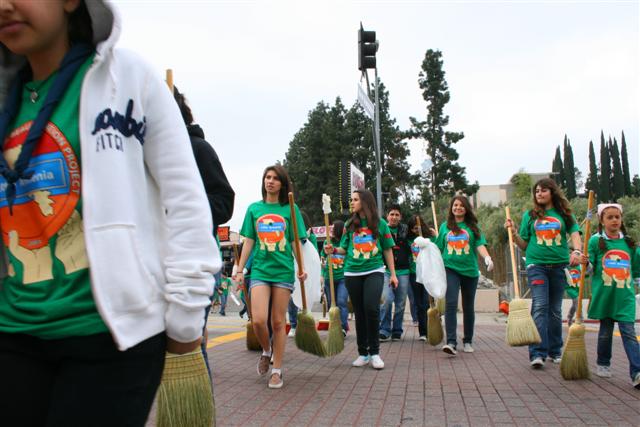 The momentum that we glimpsed and that we collectively created around the Stop the Protocols campaign was unprecedented. Our story and our collective engagement with the creation of media was viral. Not only did we engage the story, but we engaged our peers and made them active. On top of that success, our viral messages reached mainstream media, the LA Times, and all the television networks. Our Tweets and iPhone videos reached the “Tipping Point” and put our people at the forefront, at least for two weeks, during the Information Age.
The momentum that we glimpsed and that we collectively created around the Stop the Protocols campaign was unprecedented. Our story and our collective engagement with the creation of media was viral. Not only did we engage the story, but we engaged our peers and made them active. On top of that success, our viral messages reached mainstream media, the LA Times, and all the television networks. Our Tweets and iPhone videos reached the “Tipping Point” and put our people at the forefront, at least for two weeks, during the Information Age.
But why stop now? Why not continue this grassroots Armenian revolution of the 21st century and continue and build upon the creation of media messages as we did during the Protocols Campaign. And why stop at Facebook and Twitter? Why not report about all of our individual and community successes to our own media network. And why stop with our media? Why not write letters to editors, engage your lawmakers, create YouTube videos, submit stories to Current TV, Reddit, CNN iReports, and other media outlets?
This reawakening, this iZartonk, is based on your participation, you sharing your small and big steps, ideas, concerns, and news items in this whirlpool of information. The revolution, the change, can continue if you and your friends, colleagues, the Armenian community-at-large, and the world knows what we are all talking about.
Share your news, share what’s new and different, promote your successes, highlight and advertise whatever makes you proud by writing, videotaping, blogging, Tweet-ing and Facebook-ing. If you have a keyboard, you’re a journalist. If you have a video camera, you’re a reporter.
Take creating media one step further and find the candidates who are concerned about your concerns and vote them into office. If those candidates aren’t there, then you run for office, be it for your university board of regents, your town parish, church council, city council, or state or federal offices. A democracy serves the masses only when the masses serve the democracy, when they vote, when they express their concerns, and when they go door-to-door talking to people.
Why should your government, your democracy, your representatives on Capitol Hill NOT vote for Genocide recognition. That question should be enough to make you ponder whether they really care about justice and have your best interest in their hearts. Or are they merely banking on empty promises so that they can sustain their cushy jobs and their affluent lifestyles and donors?
If your representatives in government aren’t providing what you need them to provide, if they aren’t worried about your future, your career, your education, if they are able to convince you that your government needs to wage war overseas instead of fixing roads, developing new industries and renewable energy sources, then their tenure as public servants is over.
Now it’s your turn. Participate in the reawakening of the Armenian spirit, create media, voice your concerns, vote, and talk to people.
Remember, in the Information Age, we are on an equal playing field with anything that mainstream news organizations are producing. Your thoughts, your concerns, your opinions are as valid as those of the pundits who are using the mainstream channels that are in the business of making money by gathering the most eyeballs at any given time.
Don’t patronize mass media to appease their shareholders with bigger profits. Instead, create your own media and change the game. Whether you attended a protest rally on April 24, attended a book signing, wrote a play, or heard a new artist, everything is relevant to your community.
So speak up, speak loud and participate in the reawakening of the Armenian Soul through iZartonk.

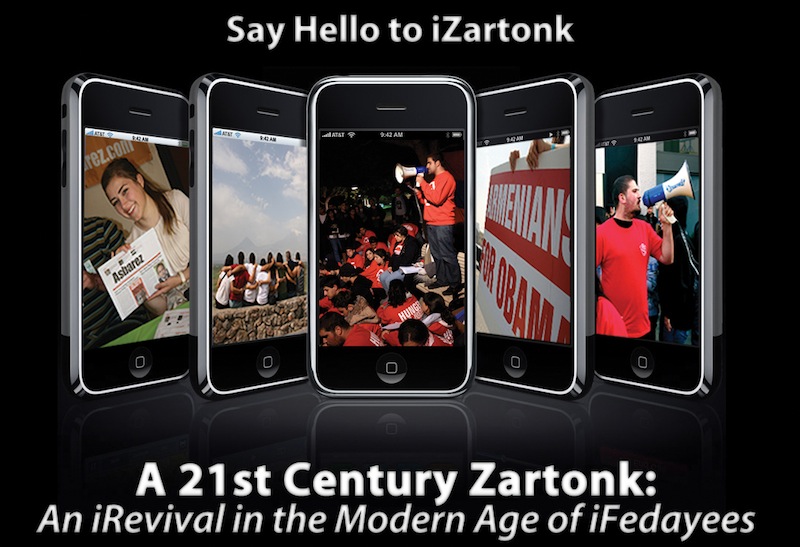
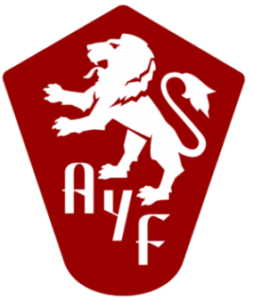
Leave a Reply
Want to join the discussion?Feel free to contribute!